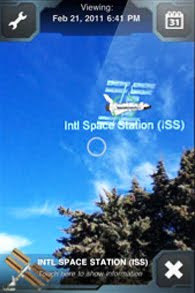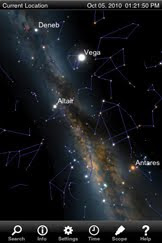 Maybe it's fitting since May sadly marks the end of the 30-year space shuttle program, but the desire for space exploration remains in the forefront for many people.
Maybe it's fitting since May sadly marks the end of the 30-year space shuttle program, but the desire for space exploration remains in the forefront for many people. There are answers out there. And some might help resolve the challenges we face down here.
Although there will be no more shuttle launches, there is growing interest in keeping our eyes pointed upward, thanks in part to several smart phone app developers blending entertainment and education.
Three apps in particular stand out, with the review focused mostly on the newest.
SkyView makes stargazers out of the gravitationally challenged.
With its initial free offering and 99 cent upgrade, SkyView goes a long way in making a beautifully compelling application for anyone. It brings stars, satellites, constellations, and celestial bodies within reach.
What makes the app incredibly attractive is its presentation. It does what it says it is going to do and does it well. It finds objects in the sky incredibly fast.
 The technology isn't new. It combines the GPS and gyroscope funtions of an iPhone to plot your location and sync the sky to your vantage point. And, because the screen drops in the real-time camera view as a backdrop, you immediately capture a sense of where everything is in relation to you.
The technology isn't new. It combines the GPS and gyroscope funtions of an iPhone to plot your location and sync the sky to your vantage point. And, because the screen drops in the real-time camera view as a backdrop, you immediately capture a sense of where everything is in relation to you.Once you've located or searched for an object, you can pull up some information about it without changing screens or plot the object's celestial path. It's basic, but fun.
Plotting paths is especially useful for photographers interested in framing sunrises and sunsets before the event. But the entire tool works well for casual astronomers or anyone who wants to point out a planet, constellation, or satellite in the night sky.
It's simple and straightforward, regardless of how much interest someone might have in space. The real draw is in the immediacy of stargazing, making anyone who has the app want to explore more.
SkyView opens the door for Star Walk.
When SkyView first entered the app store, there was an initial buzz followed by small backlash from people who were already using one of several other stargazing applications. The most well known of which is Star Walk.
While Star Walk lacks some of the sex appeal that SkyView seems to have, it's generally considered the frontrunner of augmented astronomy apps. And compared to SkyView, it easily wins on providing more in-depth information (Wikipedia-reliant) about stars and celestial bodies.
 Star Walk also works on both the iPhone and the iPad. And, although you have to leave the live screen to access it, the information often includes renderings of deep space clusters and nebulas, satellites, and even animated renderings of spinning planets.
Star Walk also works on both the iPhone and the iPad. And, although you have to leave the live screen to access it, the information often includes renderings of deep space clusters and nebulas, satellites, and even animated renderings of spinning planets.The application is robust in other ways. It includes a calendar of celestial events like planetary alignments, full moons, solar eclipses, and meteor showers. There is a quick live sky one page that details when planets will rise and set. There are semi-regularly updates of space photos and renderings.
In many ways, competition from other stargazing apps has been good for Star Walk, prodding the developer to add features it never intended to offer. Once, it even provided a specific response as to why it was not going to add the space station and satellites. And then, despite the explanation, it added them anyway.
This app (and the next) also add more functionality in that can freeze the sky frame and explore the stars without being tied to the augmented reality titling. However, when real-time sky panning is enabled, it doesn't seem as fluid as SkyView (probably because it stays true to proportions).
SkySafari upgrades its app with three giant tiers.
While most people are asking whether SkyView or Star Walk is the better app to get, Southern Stars has released its three-tier SkySafari 3 for the iPhone and iPad. The tiers — basic, plus, and pro — range in content, function, and price.
 Most notable is that although the basic lists more objects than other apps, the pro version includes almost everything known — 15.3 million stars from the Hubble Guide Star catalog, 740,000 galaxies down to 18th magnitude, and over 550,000 solar system objects. And yes, that means every comet and asteroid ever discovered.
Most notable is that although the basic lists more objects than other apps, the pro version includes almost everything known — 15.3 million stars from the Hubble Guide Star catalog, 740,000 galaxies down to 18th magnitude, and over 550,000 solar system objects. And yes, that means every comet and asteroid ever discovered. Most objects found also include detailed content with embedded images from NASA space missions, the Hubble Space Telescope, and the world's foremost amateur and professional astro-photographers. It's a nice touch, but nothing compares to the standout feature for serious stargazers. The plus and pro apps allow for wired and wireless telescope control of higher-end telescopes from Meade, Celestron, Orion, and others.
So which app is the best? It's all about what you want. If you want to point out Orion's belt to your nephew or make note that you and your girlfriend first kissed under Scorpio, SkyView ought to be enough. Star Walk and especially SkySafari are different degrees of moving toward casual astronomer to amateur or even pro.
SkyView By Terminal Eleven Sparks 5.8 On The Liquid Hip Richter Scale.
Both Star Walk by VITO Technology and SkySafari 3 by Southern Stars would easily score higher. However, I can't discount the instant gratification that SkyView affords itself as an app. It makes education entertaining and immediate. That counts.
You can find all three applications (and variations) on iTunes. SkyView is 99 cents (currently) and there is a free version. Star Walk (iPhone) is $2.99 and Star Walk (iPad) is $4.99. SkySafari 3 functions on both the iPhone and iPad, currently on sale for 99 cents. Its plus and pro versions are significantly more, about $15 and $60 respectively and some additional hardware might be required.
If any of these programs do make you more interested in astronomy, two entry-level telescopes worth considering are the Meade NG-70SM 70MM Refractor Telescope or Orion SkyScanner 100mm Reflector Telescope. They're both rated among the highest in their class for beginners for about $100 or less. Go boldly.
![Liquid [Hip]](https://blogger.googleusercontent.com/img/b/R29vZ2xl/AVvXsEjAFBQPqS7J0-rrttNoRYSsuwIePPZf4Nq6sqDioK1zzVQXJIQXKzq_NVNI4n6h3inuRQFBKOcJeZeSufkdHHIOxbSWyBjTjTxgKEQGyPzdwvkEEeECh4bI5YEGk4RWGUINSd7vulPQsCA/s1600-r/liquidhip.jpg)